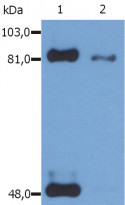ARG63103
anti-STAT1 phospho (Ser727) antibody [PSM1]
anti-STAT1 phospho (Ser727) antibody [PSM1] for Immunoprecipitation,Western blot and Human
Cancer antibody; Gene Regulation antibody; Signaling Transduction antibody
Overview
| Product Description | Mouse Monoclonal antibody [PSM1] recognizes STAT1 phospho (Ser727) |
|---|---|
| Tested Reactivity | Hu |
| Tested Application | IP, WB |
| Specificity | The clone PSM1 recognizes transcriptional factor STAT1 (91 kDa) activated by phosphorylation at Ser727. |
| Host | Mouse |
| Clonality | Monoclonal |
| Clone | PSM1 |
| Isotype | IgG1 |
| Target Name | STAT1 |
| Immunogen | STAT1 peptide sequence 721-733 (Ser727 phosphorylated). |
| Conjugation | Un-conjugated |
| Alternate Names | ISGF-3; Signal transducer and activator of transcription 1-alpha/beta; Transcription factor ISGF-3 components p91/p84; CANDF7; IMD31A; IMD31B; IMD31C; STAT91 |
Application Instructions
| Application Suggestion |
|
||||||
|---|---|---|---|---|---|---|---|
| Application Note | * The dilutions indicate recommended starting dilutions and the optimal dilutions or concentrations should be determined by the scientist. |
Properties
| Form | Liquid |
|---|---|
| Purification | Purified from hybridoma culture supernatant by protein-A affinity chromatography. |
| Purity | > 95% (by SDS-PAGE) |
| Buffer | PBS (pH 7.4) and 15 mM Sodium azide |
| Preservative | 15 mM Sodium azide |
| Concentration | 1 mg/ml |
| Storage Instruction | For continuous use, store undiluted antibody at 2-8°C for up to a week. For long-term storage, aliquot and store at -20°C or below. Storage in frost free freezers is not recommended. Avoid repeated freeze/thaw cycles. Suggest spin the vial prior to opening. The antibody solution should be gently mixed before use. |
| Note | For laboratory research only, not for drug, diagnostic or other use. |
Bioinformation
| Database Links |
Swiss-port # P42224 Human Signal transducer and activator of transcription 1-alpha/beta |
|---|---|
| Gene Symbol | STAT1 |
| Gene Full Name | signal transducer and activator of transcription 1, 91kDa |
| Background | STAT1 (signal transducer and activator of transcription 1) is a transcription factor that plays important roles in growth arrest, apoptosis promoting and tumour suppression. After ligation of cytokine receptors STAT1 becomes phosphorylated on Tyr701 by Janus kinase JAK1 or JAK2, dimerizes, translocates to nucleus and contacts DNA. STAT1-STAT2 heterodimers serve as more potent transcriptional inducers than STAT1 homodimers. STAT1 is also phosphorylated on Ser727 by MAPK pathway, independently of tyrosine phosphorylation. However, the both modifications are important for its maximal transcriptional activity. On the other hand, STAT1 phosphorylated on Ser727 is targeted for proteasomal degradation. |
| Function | Signal transducer and transcription activator that mediates cellular responses to interferons (IFNs), cytokine KITLG/SCF and other cytokines and other growth factors. Following type I IFN (IFN-alpha and IFN-beta) binding to cell surface receptors, signaling via protein kinases leads to activation of Jak kinases (TYK2 and JAK1) and to tyrosine phosphorylation of STAT1 and STAT2. The phosphorylated STATs dimerize and associate with ISGF3G/IRF-9 to form a complex termed ISGF3 transcription factor, that enters the nucleus. ISGF3 binds to the IFN stimulated response element (ISRE) to activate the transcription of IFN-stimulated genes (ISG), which drive the cell in an antiviral state. In response to type II IFN (IFN-gamma), STAT1 is tyrosine- and serine-phosphorylated. It then forms a homodimer termed IFN-gamma-activated factor (GAF), migrates into the nucleus and binds to the IFN gamma activated sequence (GAS) to drive the expression of the target genes, inducing a cellular antiviral state. Becomes activated in response to KITLG/SCF and KIT signaling. May mediate cellular responses to activated FGFR1, FGFR2, FGFR3 and FGFR4. [UniProt] |
| Highlight | Related products: STAT1 antibodies; STAT1 Duos / Panels; Anti-Mouse IgG secondary antibodies; Related news: Exploring Antiviral Immune Response circNDUFB2, a circular RNA (circRNA), activates anti-tumor immunity |
| Research Area | Cancer antibody; Gene Regulation antibody; Signaling Transduction antibody |
| Calculated MW | 87 kDa |
| PTM | Phosphorylated on tyrosine and serine residues in response to a variety of cytokines/growth hormones including IFN-alpha, IFN-gamma, PDGF and EGF. Activated KIT promotes phosphorylation on tyrosine residues and subsequent translocation to the nucleus. Upon EGF stimulation, phosphorylation on Tyr-701 (lacking in beta form) by JAK1, JAK2 or TYK2 promotes dimerization and subsequent translocation to the nucleus. Growth hormone (GH) activates STAT1 signaling only via JAK2. Tyrosine phosphorylated in response to constitutively activated FGFR1, FGFR2, FGFR3 and FGFR4. Phosphorylation on Ser-727 by several kinases including MAPK14, ERK1/2 and CAMKII on IFN-gamma stimulation, regulates STAT1 transcriptional activity. Phosphorylation on Ser-727 promotes sumoylation though increasing interaction with PIAS. Phosphorylation on Ser-727 by PRKCD induces apoptosis in response to DNA-damaging agents. Phosphorylated on tyrosine residues when PTK2/FAK1 is activated; most likely this is catalyzed by a SRC family kinase. Dephosphorylation on tyrosine residues by PTPN2 negatively regulates interferon-mediated signaling. Upon viral infection or IFN induction, phosphorylation on Ser-708 occurs much later than phosphorylation on Tyr-701 and is required for the binding of ISGF3 on the ISREs of a subset of IFN-stimulated genes IKBKE-dependent. Phosphorylation at Tyr-701 and Ser-708 are mutually exclusive, phosphorylation at Ser-708 requires previous dephosphorylation of Tyr-701. Sumoylated with SUMO1, SUMO2 and SUMO3. Sumoylation is enhanced by IFN-gamma-induced phosphorylation on Ser-727, and by interaction with PIAS proteins. Enhances the transactivation activity. ISGylated. |
Images (1) Click the Picture to Zoom In






